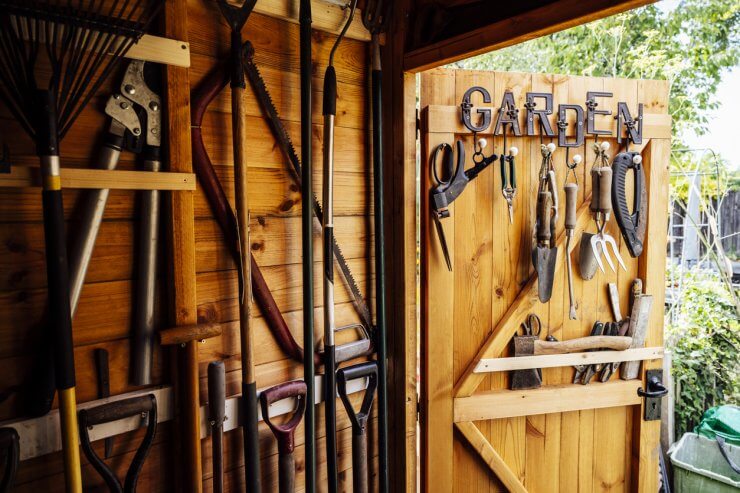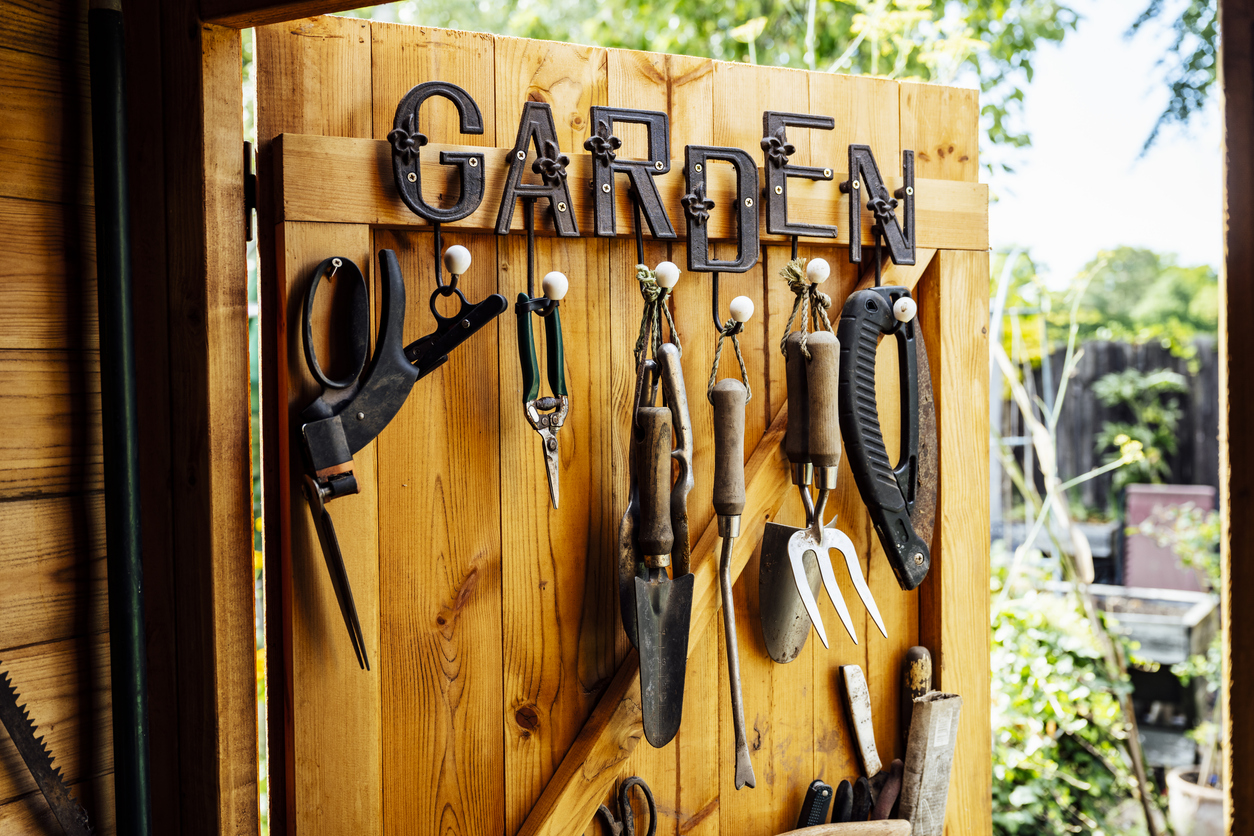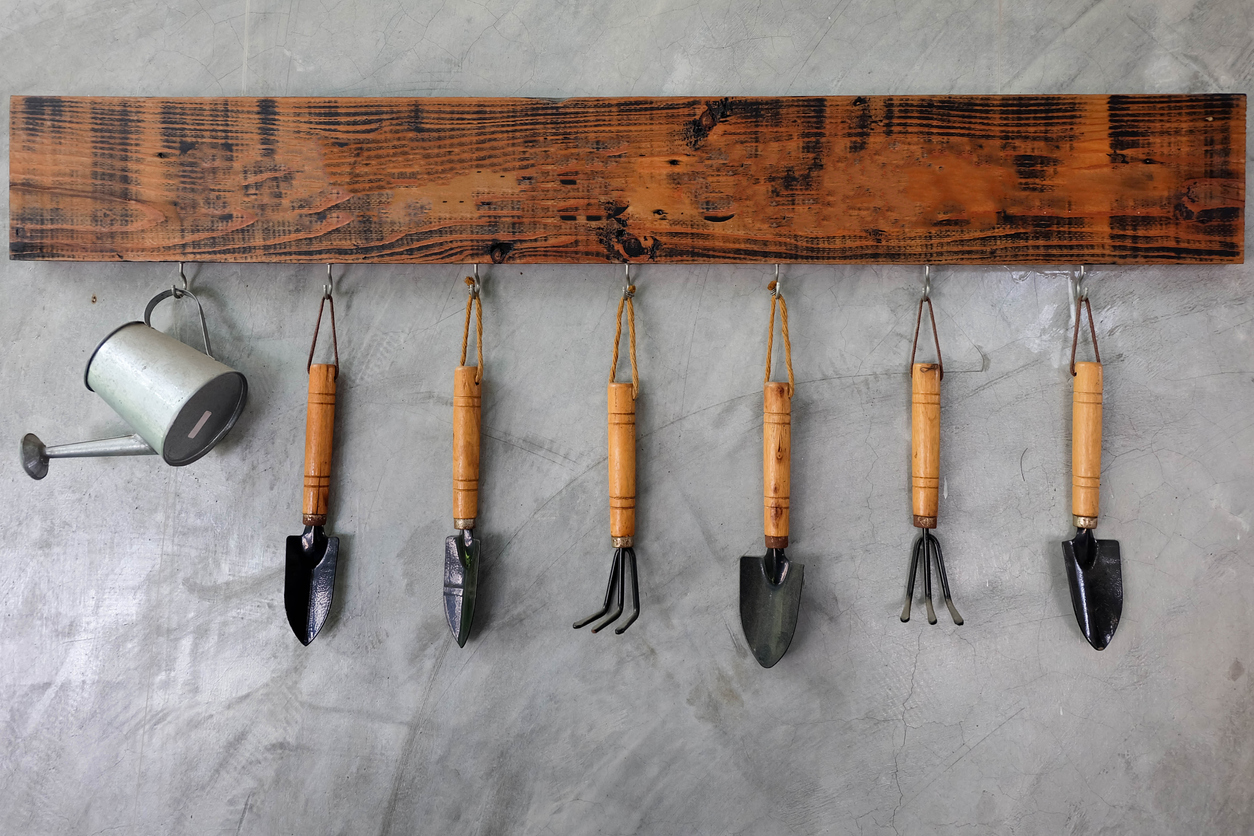
Alright, maybe calling a collection of tools a work of art is a stretch. Or perhaps it isn’t? Handmade tools can be gorgeous, with hammered metal blades and turned wood handles. But look at me – I’m already off-topic. We’re here to talk about how to organize garden tools and supplies when you aren’t using them.
Like our gardens, our garden tools and supplies go through stages. When starting seeds indoors, we need heating mats, grow lights, and seed starting trays. We use spades and pots to put our seedlings in the ground or in our container gardens. We pull out the pruning shears when our tomatoes grow suckers, or the lavender needs to be cut back. And at the end of the season, we use envelopes to save seeds and rakes to work compost into the soil.
What happens to all these tools and supplies when we aren’t using them? Pots get stacked and piled in a corner of the shed. Small tools sit haphazardly on a shelf. Shovels, hoes, and rakes lean against a corner, all mixed up. Then when you need something, you have to dig it out from underneath everything else. That bag of mulch is behind the pots, or the garden hose is in a dusty corner hidden by the lawnmower.
Gardeners, it’s time to take a stand and tell ourselves that we WILL organize garden tools and supplies this season. And this time, we’re going to mean it because we have a plan. Ready?
Discover 7 top tips for growing, harvesting, and enjoying tomatoes from your home garden—when you access the FREE guide The Best Way to Grow Tomatoes, right now!

A 5-step plan to organize garden tools and supplies so we can find what we need
As fair warning, the first time you organize garden tools, it can be a big task, especially if you’ve never done it before or you have a lot of supplies. The good news is that it’s not difficult to keep things in order once you do it the first time. I promise it will be worth the effort. The next time you need that garden fork, it will be easy to get to. When you want that specialty garden hose attachment, you’ll know exactly where it is. Everything will be clean, accessible, and ready to use.
Step 1. Clean your tools. When you clean before you organize garden tools and supplies, you set yourself up for success. You won’t find rusty shovels or baked-on mud. Your tools will be ready to go.
Step 2. Get rid of what you don’t need. I know this is a tough one. Maybe the toughest. But all those extra watering cans, cracked pots, and garden decorations that you haven’t put out in four seasons are just taking up space. Seriously, how long has that terra cotta pot been sitting there? Put it to the curb, recycle it, or whatever, but for you, it’s just taking up space.
Step 3. Remove everything and clean your space. Whether you have a garden shed, a spot in the basement, or a corner of the garage, a clean space is easier to organize. Plus, why would you want to put clean tools on dirty floors or shelves?
Step 4. Organize garden tools by size. Long-handled tools, short-handled tools, small supplies, big supplies, heavy and light – go ahead and separate them so you can make a plan.
Step 5. Put everything back. Here’s where we get to have some fun. There are about a million different organizing systems out there. Options range from pegboard with hooks to repurposed mailboxes to custom storage systems made of moon rock and hand-crafted by Zeus. But you know I like to keep things simple. So, how are we going to put everything back?
Once you’ve gotten rid of all the excess and cleaned the space, you might realize you don’t have as many tools and supplies as you thought. Then? I try to look at what I have that I can use to organize garden tools, supplies, and miscellaneous items. For example, a small basket is ideal for gloves. And we can’t forget Ball jars are the perfect storage containers for things like plant tags.
What seems most important, at least for me, is giving everything some space, so things are easy to find and get to. For example, if you can’t hang up your smaller tools, give them their own shelf where they can sit side by side. For larger tools, like long-handled rakes, if you can’t hang them up, use an umbrella stand or something similar so the handles are off the floor and the working ends are up at eye level. That makes it easy to grab the right tool without everything getting tangled up.

Specifically, here are a couple systems
Once my gardening supplies started piling up initially, I went through a few different systems for storing things, but here’s what I have found to work best in combination.
Bucket Boss for Tool Organization
I like the Bucket Boss because it turns any ol’ 5-gallon bucket into a tidy plant tool organizer. Small shovels, watering bottles, plant labels, gloves, hand rakes, and more can all fit around the inside and outside perimeter of the bucket and you can use the inner well to hold any larger items like a watering can or a small bag of potting mix.
A Small Tool Shed for Larger Items
I started hanging my garden tools in my garage, but my garage isn’t exactly close to my garden and it was a game-changer when I invested in a tool shed. I found that a small horizontal storage shed (the type with the doors on top like a bin) weren’t enough and were just plain messy and hard to use. Instead, a simple 4×6′ or 4×4′ upright shed has done the trick for me, and having it right next to my garden has saved many garden tools! If you’re limited in space, a 4×2′ works too, you may just be short on space for trellises and tomato cages.
If you get a big enough tool shed, you can also use it to store extra soil. If you have a greenhouse, that’s a great place to store soil as well, under the beds.
One word of advice that will help prevent accidents is to keep heavier items on the bottom shelves and work your way up with the lightest items on the top shelves. That helps lower the center of gravity for freestanding shelves, and if you drop something from a top shelf, it’s better if it’s a few packs of seeds that land on your foot than it is a 20-pound pot.
How do you organize your garden tools? I’d love to read your ideas in the comments.
Discover 7 top tips for growing, harvesting, and enjoying tomatoes from your home garden—when you access the FREE guide The Best Way to Grow Tomatoes, right now!




